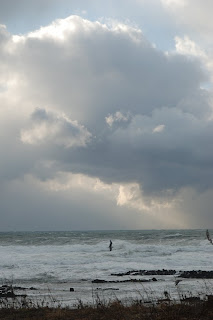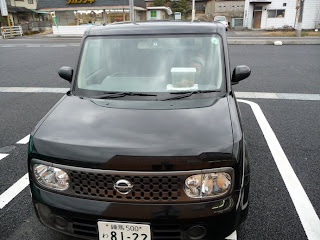Cool shopping trolleys!
 On the way back to Kanazawa [金沢] from the Noto Peninsular [能登半島] we stopped by at a bug out-of-town shopping mall, which had these lovely shopping trolleys (unfortunately unavailable in adult sizes)
On the way back to Kanazawa [金沢] from the Noto Peninsular [能登半島] we stopped by at a bug out-of-town shopping mall, which had these lovely shopping trolleys (unfortunately unavailable in adult sizes)


A blog, created mainly for my own benefit (as I have the mental retention capacity analogous to a very large aperture sieve trying to hold water), but it also has the dual purpose of letting you guys know what I'm up to. I also have a tendency to prattle on about other stuff too, if I have the time. Check the 'Interlude' thing for updates...or prattles that don't quite make a blog post.
 On the way back to Kanazawa [金沢] from the Noto Peninsular [能登半島] we stopped by at a bug out-of-town shopping mall, which had these lovely shopping trolleys (unfortunately unavailable in adult sizes)
On the way back to Kanazawa [金沢] from the Noto Peninsular [能登半島] we stopped by at a bug out-of-town shopping mall, which had these lovely shopping trolleys (unfortunately unavailable in adult sizes)


Overlord of scripture:
wayway
at
15:38
0
Monkey-do-das
![]()
Labels: Just for Fun
 We drove up the Noto Peninsula from Kanazawa, just to see what it was like.
We drove up the Noto Peninsula from Kanazawa, just to see what it was like.
Overlord of scripture:
wayway
at
14:30
0
Monkey-do-das
![]()
Labels: Ishikawa 石川県, Sightseeing
 Kanazawa [金沢] is in Ishikawa Prefecture [石川県], up near the inside of the 'elbow' of Japan, facing the Japan sea. Unfortunately, the weather was not so good when we went. So the photos all look a bit dreary...
Kanazawa [金沢] is in Ishikawa Prefecture [石川県], up near the inside of the 'elbow' of Japan, facing the Japan sea. Unfortunately, the weather was not so good when we went. So the photos all look a bit dreary...

Overlord of scripture:
wayway
at
13:31
0
Monkey-do-das
![]()
Labels: Ishikawa 石川県, Sightseeing


Overlord of scripture:
wayway
at
22:02
0
Monkey-do-das
![]()
Labels: Gifu 岐阜, Sightseeing
Overlord of scripture:
wayway
at
14:19
0
Monkey-do-das
![]()
Labels: Gifu 岐阜, Sightseeing
Overlord of scripture:
wayway
at
12:13
0
Monkey-do-das
![]()
Labels: Food and Drink, Gifu 岐阜, Sightseeing
Overlord of scripture:
wayway
at
11:21
0
Monkey-do-das
![]()
Labels: Nagano 長野, Sightseeing




Overlord of scripture:
wayway
at
00:21
3
Monkey-do-das
![]()
Labels: Food and Drink, Nagano 長野, Sightseeing
Overlord of scripture:
wayway
at
23:01
0
Monkey-do-das
![]()
Labels: Fish, Food and Drink, Just for Fun
After a long and hard ten days, our fishy was tired and looking a little stressed (that and his water was getting dirty after only one day as opposed to one week resulting in him swimming in a tank of filth for a the last few days). So we decided that it was time for him to get a tank. An actual tank with a filter and more pebbles, as opposed to the plastic bread box he had been living in.
Overlord of scripture:
wayway
at
21:51
0
Monkey-do-das
![]()
Labels: Fish
 Right. so. We didn't make it back to Europe for holidays this Christmas because;
Right. so. We didn't make it back to Europe for holidays this Christmas because;
1. When we were planning the winter holidays back in Sept, the plane ticket prices were a little too high for my liking,
2. We thought that we had better make the best use of our time in Japan by seeing a bit of the country while we were here,
3. We also thought we could do our bit in boosting the Japanese economy.
So, we've ended up spending what we would have spent on just an air ticket to Paris or London on a 10day road trip around Nagano [長野県] and Gifu [岐阜県] Prefectures (which are North and North-Westy of Tokyo).
As Greg has a French driving licence - he could do a direct transfer to a Japanese drivers licence (unlike my British one which involves another test...hmmm...no thanks) so we rented a car from Nissan via ToCoo!.
The plan was too drive along the Chuo Highway [中央道] out of Tokyo towards Tsumago [妻籠] and Magome [馬籠], stop there in a minshuku [民宿] for a night and do a bit of sightseeing before heading off to Shirakawago [白川郷].
 Tsumago [妻籠] and Magome [馬籠] - Designated a site of National Architectural Preservation where you can still find an Edo-style post town in its entirety.
Tsumago [妻籠] and Magome [馬籠] - Designated a site of National Architectural Preservation where you can still find an Edo-style post town in its entirety. Minshuku [民宿] - A guest house run by the family which live inside the house itself, usually offering dinner and breakfast.
Minshuku [民宿] - A guest house run by the family which live inside the house itself, usually offering dinner and breakfast. Shirakawago [白川郷] - A village in Gifu Prefecture famous for it's traditional farm houses with steep-sided thatched roofs.
Shirakawago [白川郷] - A village in Gifu Prefecture famous for it's traditional farm houses with steep-sided thatched roofs.
Overlord of scripture:
wayway
at
19:50
0
Monkey-do-das
![]()
Labels: Gifu 岐阜, Holiday, Nagano 長野, Sightseeing

| Earn an online associates degree . |